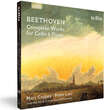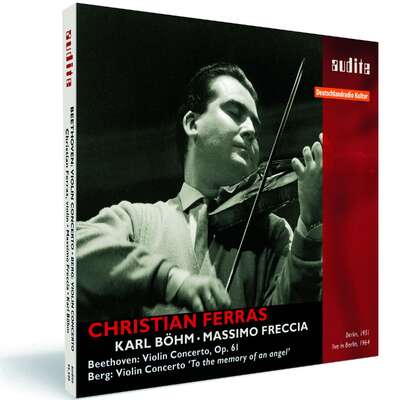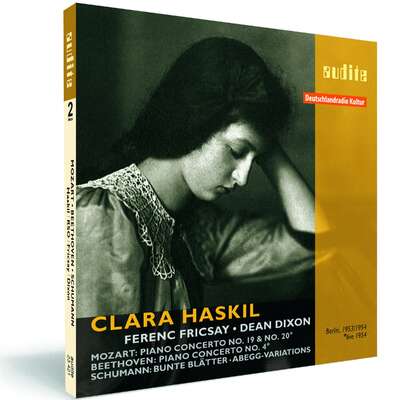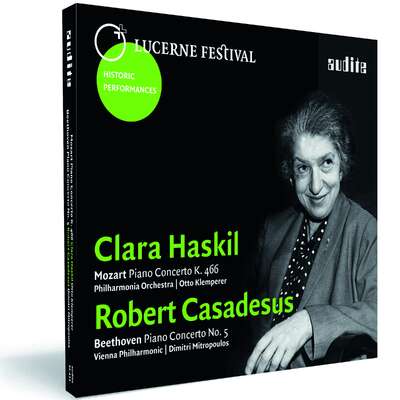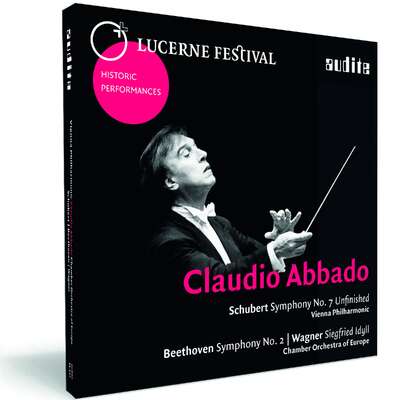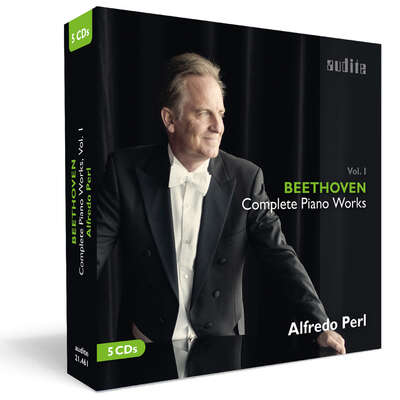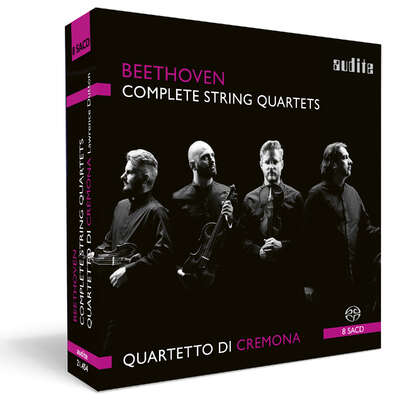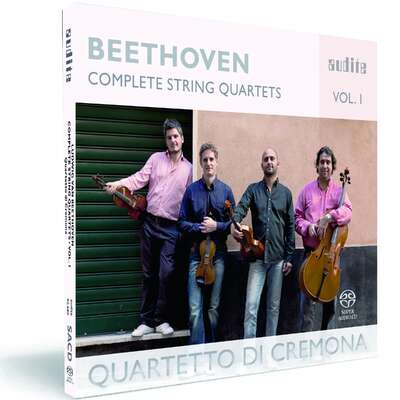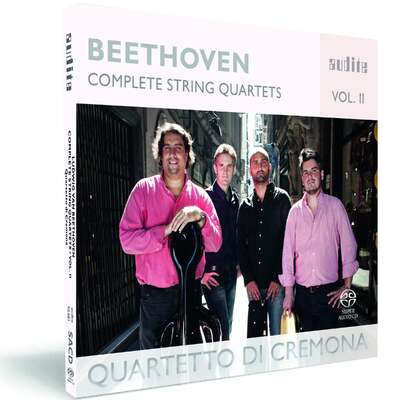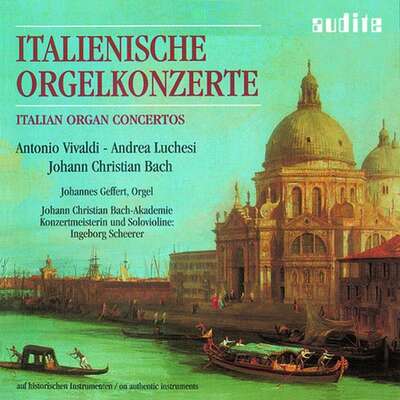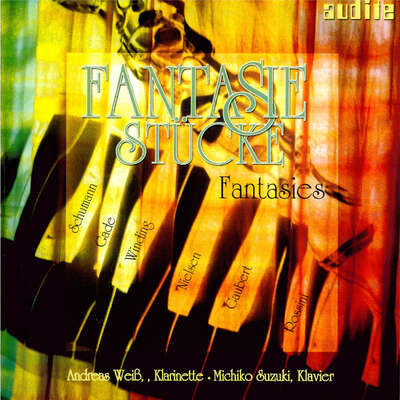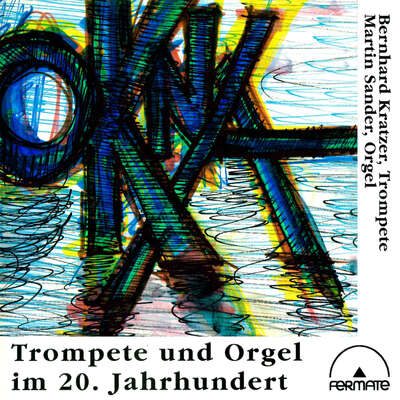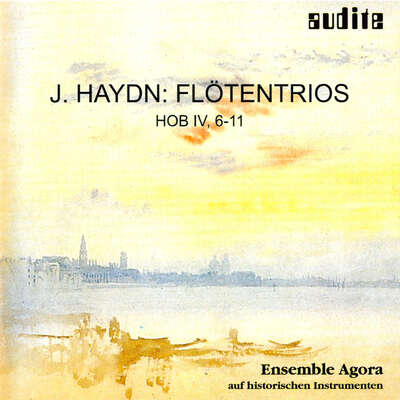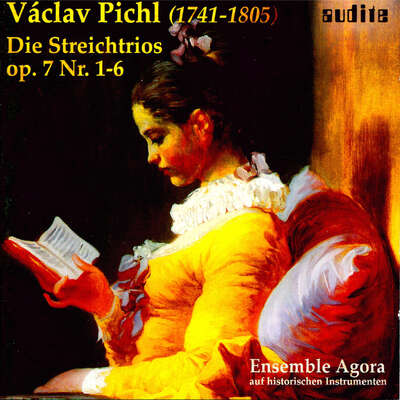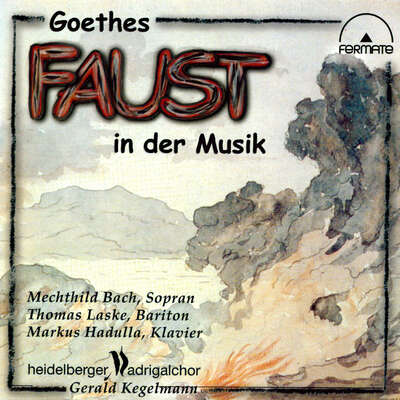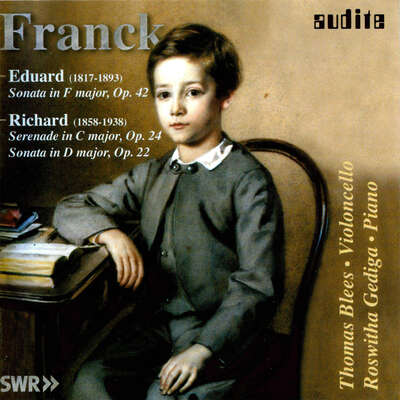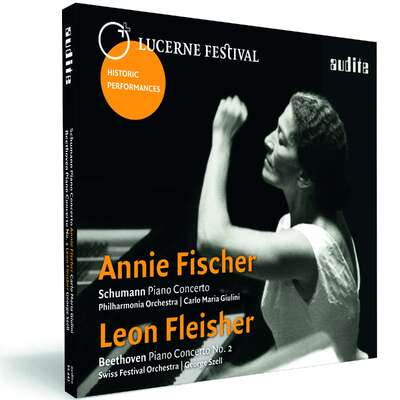
Auto-Rip
Beethoven live in St. Petersburg: Der Mitschnitt des Konzerts aus dem Kleinen Saal der St. Petersburger Philharmonie ist geprägt von der mitreißenden Musikalität und technischen Perfektion der Musiker. Interpreten und Publikum bilden im traditionsreichen Saal eine Einheit, in der Spielfreude und Einfallsfülle der Werke besonders intensiv erlebbar werden.mehr
"Mit seinem warmen und edlen Celloton bleibt Coppey den Werken weder in ihren sensiblen Aussagen noch in ihrer Virtuosität etwas schuldig." (Pizzicato)
Titelliste
Details
| Ludwig van Beethoven: Complete Works for Cello and Piano | |
| Artikelnummer: | 23.440 |
|---|---|
| EAN-Code: | 4022143234407 |
| Preisgruppe: | BCE |
| Veröffentlichungsdatum: | 6. April 2018 |
| Spielzeit: | 144 min. |
Zusatzmaterial
- Digibooklet
-
Peter Laul & Marc Coppey über das Aufnahmekonzept
in deutscher, englischer und russischer Sprache
Informationen
Livekonzert aus St. Petersburg:
Insgesamt acht Werke für Violoncello und Klavier hat Beethoven geschrieben. Sie sind an Spielfreude und Einfallsfülle kaum zu überbieten - die Livesituation der Aufnahme fängt dies besonders gut ein. Der Franzose Marc Coppey und sein St. Petersburger Klavierpartner Peter Laul musizieren voller Energie und Temperament und verleihen den populären Variationen und gewichtigen Sonaten unbestechlichen, glitzernden Klang. Die technische Perfektion der Musiker ist auch in der Livesituation beeindruckend.
Als Konzertsaal für ihr „Marathon-Konzert" mit den Beethoven'schen Werken haben sie den Kleinen Saal der St. Petersburger Philharmonie gewählt: Sein traditionsreiches, historisches Ambiente und das bis zur letzten Note aufmerksam lauschende Publikum schaffen gleichermaßen Atmosphäre und Inspiration. Beides zeichnet die vorliegende Aufnahme aus und unterscheidet sie von den sonst meist im Studio produzierten Gesamtaufnahmen der häufig gespielten Werke. Der Steinway der Philharmonie und das Aufnahme-Equipment aus den ehemaligen Melodya-Studios vervollständigen das Petersburger Ensemble.
Besprechungen
www.amazon.de | 1. September 2019 | Weidong Zhang | 1. September 2019 | Quelle: https://www.amaz... Customer Review: Beautiful and stylish interpretation of Beethoven cello works
I have a collection of 20+ Beethoven cello sonatas and variations and this one is one of my favorites. Marc Coppey's flawless technique serves theMehr lesen
The Classical Review | May 13, 2019 | Tal Agam | 13. Mai 2019 | Quelle: https://theclass... Double Review: Beethoven – Cello Sonatas – Marc Coppey, Leonard Elschenbroich
The Beethoven Cello Sonatas discography has always been very generous, yet these sonatas still stand somewhat in the shadow of Beethoven’s otherMehr lesen
Comparing the two cycles are a rewarding experience. First, these are two highly impressive and enjoyable performances. Coppey and Laul are recorded live at St Petersburg Philharmonia, and their performances are the more spontaneous-sounding of the two. Coppey’s voice has an emotional intensity that shines through even in the classical influenced Op. 5 sonatas. Laul is attuned to the dramatic contrasts in Beethoven’s piano writing and his sharp attacks are effectively conveyed when called for.
Turning to Elschenbroich and Grynyuk in the early sonatas, and you’d find a more reserved, even refined playing, with broader tempos and emotional projection in check. There is more patience in their transition from the slow introductions to the faster allegros on both of the Op. 5 sonatas. Grynyuk’s playing is honestly and simply conveyed, and the balance between the pair is superb. The results, though, is less exciting than Coppey et Laul, or less unpredictable, depending on your taste.
Elschenbroich and Grynyuk let loose some in the Op. 69, with a highly successful account of the most famous piece of the cycle. They make the best of the short Bach quote from St. Johannes Passion at the beginning of the development section, clearly see it as the highlight of the first movement. Turn to Coppey and Laul and you’ll meet an even more tumultuous Op. 69, where the development section is played with sharp attacks and direct tone that’s hard to resist. Not everyone will be convinced by the slowing down at the beginning of the Bach quote, though (6:45, track 1 in the second CD). Overall, it’s the same conundrum – Coppey and Laul are more charged with energy and with what sounds like on-the-spot decisions, while Elschenbroich and Grynyuk are calmer, organized and planned, their musical ideas projected with more subtleness. Coppey and Laul are apt for more humor in the Scherzo too, while Elschenbroich and Grynyuk are more nervous.
Elschenbroich and Grynyuk’s more reserved approach is very suitable to their take on the late Op. 102 sonatas. This is also where Grynyuk is at his best – Listen to his superb voicing at 0:55 of the last sonata’s slow movement. Coppey and Laul’s more public approach, quite literally, takes away from the music’s inwardness. Yet the fugue that finishes the cycle is prepared with a suspenseful grin, in contrast to, yet again, the seriousness of Elschenbroich and Grynyuk.
Another two impressive additions to a tough competitive catalog, then. The live set is exciting as any, with a recording that is transparent yet tends to the edginess in the loud passages. Elschenbroich and Grynyuk are better and more intimately recorded at the studio, with a more steady, reflective approach. Both deserve your attention, along with highly successful alternatives (linked below) – namely Miklós Perényi and András Schiff (ECM), Alfred Brendel and son Adrian on Phillips/Decca and Xavier Phillips and François-Frédéric Guy on little Tribeca. Not to mention the legendaries accounts by Mstislav Rostropovich and Sviatoslav Richter, or Pablo Casals’ early cycle released by Naxos.
Record Geijutsu | Nov. 2018 | 1. November 2018
Japanische Rezension siehe PDF!Mehr lesen
American Record Guide | September / October 2018 | David W Moore | 1. September 2018
Here are two identical programs handled, similar but different. The first thing I notice about Linden and Breitman is their emphasis on early musicMehr lesen
The concept is good. Unfortunately, the players don’t work closely together in phrasing; and Linden plays with notable lack of sensitivity and poor intonation. This is not as evident in the earlier works as in the later three sonatas that are really not worth hearing under these conditions. Breitman needs a better partner.
Coppey and Laul put forward a much more effective case for this great music. Their sound is well balanced, the recording much more satisfying. These recordings were made at a concert in Moscow. There seems very little audience noise and no applause, and the players are technically remarkable. Coppey plays a Goffriller cello from 1711. These two musicians play together as one, and their sensitivity for when to pause and how to make the most of Beethoven’s music is just as I would wish to play it myself. In a word, these are outstanding interpretations of some of the greatest cello music.
Marc Coppey was winner of the Bach Competition Leipzig back when he was 18 and has done well since. I loved his Bach Suites (Aeon 316; M/J 2004) and Don Vroon praised his Haydn and CPE Bach concertos (Audite 97716; J/A 2016). Here is another winner, up there with the best I have heard.
Gramophone | August 2018 | Richard Bratby | 1. August 2018
Beethoven’s solo cello music is enjoying a moment in the sun right now, with a series of excellent new recordings (including François-FrédéricMehr lesen
But while the recorded acoustic – which slightly favours the piano – is reasonably well balanced and clear, this still feels unmistakably like live performance. The tension can be exhilarating: sforzando chords explode off the page; there’s an exuberant theatricality to the extraordinary cadenza-à-deux near the end of the first movement of Op 5 No 1; and the livelier variations – as well as the Haydnesque finales of Op 5 No 2 and Op 69 – go with a headlong swagger and a swing.
In short, there’s a continual static-buzz of excitement throughout these two discs. These are performances of extremes, with a strong leaning to the extrovert, and you might prefer more of a sense of inwardness and space in the slower variations, say, or the Adagio of Op 102 No 2. Moments of reflection are rare here, and the questioning, fantastic mood that opens Op 102 No 1 doesn’t really survive the first Allegro, just as the pair never find an entirely persuasive path between lyricism and display in Op 69. Marc Coppey’s cello tone, mellow on the lower strings, can be slightly constrained at altitude, while Laul’s bright, bravura pianism leaves little scope for mystery or indeed refinement.
If asked to choose, I’d say the G minor Sonata, Op 5 No 2, is perhaps the single most convincing performance here; it’s a work that thrives on volatility and outsize gestures. This is not to belittle Coppey and Laul’s achievement, or the verve and conviction of these performances. But a thrilling live occasion doesn’t always make for a great recording, and this set is perhaps too headstrong and too relentless for endto-end listening. No one wants vanilla Beethoven but there is more subtlety to this music than you’ll find here. And, at present, it’s fairly easy to find it elsewhere.
Fanfare | August 2018 | Huntley Dent | 1. August 2018
The back story behind this new set of Beethoven’s cello-and-piano music is detailed in a personal note from French cellist Marc Coppey. He andMehr lesen
In the event, half of this partnership turned out to be exciting and charismatic, but curiously, it wasn’t the cellist. Laul, a prizewinning pianist who studied at the St. Petersburg Conservatory and now teaches there, takes full advantage of the equality that Beethoven provides for the piano in the last three sonatas, the middle-period op. 69 and the two enigmatic late sonatas of op. 102. His passagework is brilliant and ebullient. He phrases beautifully in the slow movements and supports the rhythm of the scherzos with brio. It’s ironic that Beethoven is acknowledged as the first important composer to take the cello seriously as a solo chamber instrument, liberating it once and for all from a drone-like existence playing continuo (although Haydn did sometimes provide more opportunities, briefly, to shine in his piano trios).
Seeming to avoid the limelight, Coppey is ill-matched to his sparkling piano partner. Much of the time he sounds recessive, which could be partially blamed on microphone placement. But engineers aren’t responsible for such plainness and lack of enthusiasm. I went back to the outstanding Beethoven set from Ralph Kirshbaum and Shai Wosner (Onyx), whom I extolled in Fanfare 40:5. A world of differences sprang from the loudspeakers—Kirshbaum produces a vibrant tone that constantly varies in color. He’s eager to shine in solo passages but also combines beautifully with Wosner’s piano part. The stylistic range of the Beethoven cello sonatas encompasses his whole career, from early Classical formality to middle-period extroversion and late-period opacity (the first movement of op. 102/1 sounds positively ugly to me). Kirshbaum-Wosner welcome the challenge to explore each style on its own terms.
But not Coppey, who has only one tone—a fairly thin, whiny, and unattractive one to my ears. As an interpreter, he has his moments, as in the allegros of the two op. 5 Sonatas and their opposite, the slow music in the two op. 102 Sonatas. I discovered only one captivating reading, of the very personal Adagio con molto sentiment d’affeto, which is the second movement of op. 102/2. Like much of the basic materials in the last two sonatas, this movement begins with a spare, unpromising theme that barely departs from a scale, yet as it unfolds and deepens, Coppey and Laul begin to commune and communicate on a moving level. Touches of this rapport appear here and there, but not enough.
I don’t feel the need to diagram the disappointing readings that the Handel and Mozart variations receive; they seem run-of-the-mill. Humor and variety are not present. As for the risk-taking and electricity that Coppey speaks of in his note, well…
I joined Steven Kruger, Jerry Dubins, and Raymond Tuttle in warmly welcoming Coppey’s arresting playing on a CD that paired the Dvořák Cello Concerto and Bloch’s Schelomo (41:2 and 41:3), all of us praising the freshness of his approach to very familiar scores. Where that artist has gone mystifies me, and perhaps others will hear virtues in this new Beethoven set that elude me. As urgently as I can recommend Kirshbaum and Wosner, Coppey leaves me cold, but with a nod to Laul for his enlivening contribution.
Diapason | N° 670 Juillet - Août 2018 | Martine D. Mergeay | 1. Juli 2018
Le dialogue de Manuel Fischer-Dieskau (fils de Dietrich) avec la Canadienne Connie Shih conjugue les sonorités pures, modérément vibrées et trèsMehr lesen
A I'autre bout de la galaxie, Audite confie les cinq sonates et les trois cahiers de variations au violoncelliste francais Marc Coppey et au pianiste russe Peter Laul. Les variations bénéficient, contrairement au jeu un peu maigre de Connie Shih, d'un piano ne demandant qu'a se faire Iyrique, chaleureux ou brillant, devant son partenaire (qui garde un peu plus de réserve). Forts du lien organique avec un répertoire qu'ils pratiquent ensemble depuis plus de vingt ans, Coppey et Laul habitent un Beethoven résolument romantique, porté par de grandes envolées et, pour le coup, par une tension considérable. Un tour de force dans ces tempos très lents (trop pour l'Opus 15 n° 1). Les interprètes visent la grande ligne ; le déroulé dramatique de la partition, avec ses alternances de véhémence et de confidence, I'emporte sur le relief contrapuntique. Pour I'esprit, pour I'humour évasif ou féroce, mieux vaut retourner à quelques versions d'élite – ca cogne plus d'une fois, et le scherzo de l'Opus 69 est carrément lourdaud ... L'énergie foisonnante du duo serait sans doute irrésistible dans la salle de concert, mais à I'épreuve du disque, elle avoue quelques limites.
A Tempo - Das Lebensmagazin | Juli 2018 | Sebastian Hoch | 1. Juli 2018 Alles ist hier anders
Der französische Cellist Marc Coppey, technisch glänzender Könner an seinem Instrument, ist nun gemeinsam mit seinem nicht minder virtuosen russischen Klavierpartner Peter Laul das Risiko eingegangen, das Gesamtwerk Beethovens für Violoncello und Klavier [...] als Livekonzert aufzunehmen. [...] Und dieses Risiko lohnte: Selten ist das ungewöhnliche und sonderbare, das befreiende und schöne der Cellowerke Ludwig van Beethovens überzeugender nachhörbar geworden [...].Mehr lesen
Infodad.com | June 28, 2018 | 28. Juni 2018 | Quelle: http://transcent... Beethoven and Brahms: still surprising
Only musicians of the highest caliber would even be likely to attempt a survey of this sort on the basis of live recordings. That Coppey and Laul bring it off successfully is genuinely remarkable. The two play together with such solidity and refinement that it is often impossible to say which of them is taking the lead and who is taking the accompaniment role.Mehr lesen
Strings Magazine | June 15, 2018 | Laurence Vittes | 15. Juni 2018 | Quelle: http://stringsma... Cellist Marc Coppey on Beethoven’s Works for Cello & Piano
Marc Coppey‘s superb new recording of Beethoven’s five sonatas and three sets of variations for cello and piano (Audite) with Peter Laul exploresMehr lesen
The two sets of Magic Flute variations actually sound like an homage to Mozart, while the concluding Fugue for the last Sonata has a serenity and resignation of command that suggests Prospero. Despite having played the music for 20 years, Coppey and Laul make seemingly spontaneous discoveries and show this with communicative awareness of a narrative that makes live performances so special.
Playing his 1711 Goffriller, using a modern French bow, a mix of gut and metal strings, and the blue Henle edition of the score, Coppey finds a magical, illuminating groove that perfectly integrates the hip and the modern.
Coppey opted for the Small Hall of the St. Petersburg Philharmonia, where the premieres of Haydn’s Creation (1802) and Beethoven’s Missa Solemnis (1824) took place. The hall’s resident Steinway and the recording equipment from the former Melodiya studios completed the Saint Petersburg ensemble.
I spoke to Marc just before his annual chamber music festival in Colmar, France.
Does Beethoven’s music for cello also separate out in three periods, like the quartets and piano sonatas?
I think so. In the first two sonatas he is not as daring and the balance is very much in favor of the cello. The third one, however, has the kind of perfect balance that other major middle-period Beethoven has, like the Razumovsky Quartets and the Violin Concerto. He uses both instruments with absolute freedom and it’s total cello—with an incredible balance between their expressive capacities and tonal qualities.
And the last two sonatas, Op. 102, must be the late period.
The last two sonatas are what make it a unique set. Of course they’re smaller than the late quartets, but only the quartets, the piano sonatas, and the cello sonatas have these three major phases. And in this last phase for the cello sonatas it’s about anything you can imagine that can happen between two instruments.
Such as?
Such as the absurd fugue between two manifestly unequal fugue partners in the last movement of the last sonata. And to think that it comes after the only really slow movement in the whole set. But even though it’s a joyful, jubilant fugue, Beethoven still embraces within it the tender feelings associated with his close friend and its dedicatee Countess Anna Marie Erdödy. The last sonata is also in the long tradition, from Bach to Schoenberg, of the opposition between D major and D minor representing death and transfiguration, or death and resurrection. This last sonata is part of that and closes the five sonatas in the most glorious way
How early did you begin playing Beethoven?
I started playing Beethoven when I was really young, ten or 11. My teacher came with the music to my lessons and read them with me. I had only been playing the cello for two years but I still have a vivid memory of hearing the music for the first time. You know, Beethoven wrote wonderfully for the cello because he knew everything there was to know about the instrument, and so I learned to love the cello.
Why are your Magic Flute variations so successful?
From his earliest years, Beethoven combined the different voices of the cello; in the Magic Flute variations it sounds like each variation was for a different person onstage. They are like little operas that define the modern cello being an instrument that is more than beauty and being close to the human voice. In these variations Beethoven is close to human voices plural, as if he were speaking to us through the cello. There is something in general about the quality of the cello which lends itself to storytelling because of the variety and the dramatic aspects of the sound.
You recorded in St. Petersburg because of the connection to the first performances of Beethoven’s works, many of which took place there during his lifetime.
And because of the great acoustics, and the wonderful audiences. You can really project in the hall’s powerful, generous acoustic—but it’s not too big either, it’s very well balanced. There were a few cellists and musicians at the performances; but mostly the general public. The hall was sold out. It’s like that in Russia; audiences there are really passionate.
You recorded over two nights.
It was a challenge, but we’d been playing the sonatas for 20 years, and felt we could handle it. We were also at a phase in our lives when we felt more into the risk of live concerts—and basically because playing Beethoven not on the edge is not being Beethovenian.
opushd.net - opus haute définition e-magazine | 05.06.2018 | Jean-Jacques Millo | 5. Juni 2018 | Quelle: http://www.opush...
With exalting energy, spontaneity at each moment, and undeniable expressive fervor, Marc Coppey and Peter Laul give Beethoven’s music a true “face;” here it is at its most inventive, at its warmest, at its most authentic, one could say. The passion of these two artists is evident from beginning to end of these admirable scores, offering, sharing the most human character of a creator of genius. This is art in its universal dimension.Mehr lesen
Fono Forum | Juni 2018 | Ole Pflüger | 1. Juni 2018
Wenn ein markerschütternder Ton in ein ansonsten stilles Notenfeld kracht oder Brüllen unvermittelt zum Flüstern wird, haben Marc Coppey und PeterMehr lesen
F. F. dabei | Nr. 11/2018 26. Mai bis 8. Juni | 26. Mai 2018
Der Franzose Marc Coppey und sein St. Petersburger Klavierpartner Peter Laul musizieren voller Energie und Temperament. Mehr lesen
www.ResMusica.com | Le 15 mai 2018 | Maciej Chiżyński | 15. Mai 2018 | Quelle: http://www.resmu...
Pour son troisième album chez le label Audite, Marc Coppey s’aventure àMehr lesen
www.pizzicato.lu | 17/04/2018 | Remy Franck | 17. April 2018 | Quelle: https://www.pizz... Fein differenzierter Beethoven
Nach den so konträren Einspielungen durch Friedrich Kleinhapl und Andreas Woyke sowie Jean-Guihen Queyras und Alexander Melnikov bietet dieseMehr lesen
Der französische Pianist Marc Coppey und der russische Pianist Peter Laul haben die acht Werke im Kleinen Saal der St. Petersburger Philharmonie aufgenommen.
Die beiden ersten Sonaten werden noch ungemein leicht und charmant gespielt, als erste Versuche Beethovens in einer Gattung, die er gewissermaßen erfand. Auch die Variationen profitieren von dieser Eleganz und dem damit verbundenen Charme.
Mit seinem warmen und edlen Celloton bleibt Coppey den Werken weder in ihren sensiblen Aussagen noch in ihrer Virtuosität etwas schuldig. Auffallend und durchaus wertvoll ist die Präsenz des Klaviers, das nicht als Begleiter in den Hintergrund gedrängt wird, sondern vollwertig mitgestaltet.
Die Sonate op. 69 und die zwei letzten Sonaten op. 102 verlangen mehr Gestaltungsmittel, und die halten die beiden Interpreten bereit. Sehr wirkungsvoll sind Coppeys feuriges Drauflosgehen ebenso wie sein zarter, oft sehr reflektiver Lyrismus oder sein behagliches Schnurren, kurz gesagt, die Fülle von verschiedenen Ausdrucksmitteln, die Beethoven zugutekommen. Doch auch Peter Laul verdient höchstes Lob. Er ist gestalterisch perfekt eingebunden und spielt so sehr mit Farben und Schattierungen, dass das Dialogieren mit dem Cellisten für den Zuhörer sehr attraktiv wird.
Fresh, bright and unmannered, well differentiated performances of Beethoven’s music for cello and piano. The recording is very well balanced, giving the piano a strong but obviously correct presence.
www.qobuz.com | 6. April 2018 | Sandra Zoor | 6. April 2018 | Quelle: https://www.qobu... Marc Coppey & Peter Laul spielen Beethovens Werke für Violoncello und Klavier in der St. Petersburger Philharmonie
Der Franzose Marc Coppey und sein St. Petersburger Klavierpartner Peter Laul musizieren voller Energie und Temperament und verleihen den populären Variationen und gewichtigen Sonaten unbestechlichen, glitzernden Klang. Die technische Perfektion der Musiker ist auch in der Livesituation beeindruckend.Mehr lesen
Radio Coteaux | 01 Avril 2018 | 1. April 2018 | Quelle: http://www.radio... BROADCAST
Sendebeleg siehe PDF!Mehr lesen
Image Hifi | 5/2018 | Heinz Gelking Zurücklehnen und genießen
Coppey und Laul spielen auf durchgehend höchstem Niveau und in hellwacher Partnerschaft.Mehr lesen
